Hunter_Compton
Member
Part 1: History
The name Kodak, while familiar to any photographer, is not one normally associated with high-end photographic instruments. Indeed, one of the philosophical principles first put forward by George Eastman is the vast distribution and use of inexpensive snapshot cameras, the use of which ensured the continued sale of Kodak film. This philosophy has been associated with the Brownie camera and its successors, perhaps unfairly branding Kodak with the reputation that they were only ever capable of building low quality cameras.
However, if one is observant of history it will be apparent that there are several Kodak cameras which challenge this assertion. These examples originate from an era or approximately 1936 to 1956 in which American photographic manufacturing was given a brief opportunity to compete on the world stage against foreign competition. The looming and destructive war in Europe and Asia, gave American manufacturers a window in which German and Japanese competition did not besiege their products. Only in the aftermath of the war was international optics manufacture once again able to displace American products.
Taking advantage of this window, manufacturers such as Argus, Perfex and Clarus put their products on the market for American consumers. However, the cameras built by these companies are not comparable to their foreign competitors of the pre-war era. Perfex and Clarus have a reputation of poor quality control, and while Argus was quite successful, I doubt anyone would claim the C3 as matching the specifications of a pre-war Leica or Contax.

The Eastman Kodak Company, the largest producer of photographic products in the United States at this time, was not to abandon this opportunity either. Where other companies were content to target the market for the advanced amateur or snapshooter, Kodak built a number of cameras which largely targeted the professional market, and in doing so created some of the most technologically advanced cameras to ever come out of an American factory. In 1936, Kodak announced the Bantam Special, a miniature camera designed for the 828 format, it featured a striking geometric appearance and the 44mm Ektar f/2.0 was at the time the fastest lens Kodak ever put on a still camera to come out of Rochester. In 1938, Kodak released the Super Six-20, the first camera to have aperture priority auto exposure, a feature which would not be common until the late 1950s. In 1941, Kodak released two more cameras for this intended market. The Ektra was a 35mm system camera with interchangeable coated lenses of varying focal lengths, removable film backs and a slew of other features which made it the most advanced 35mm camera of its era.
The second of these was a unique solid bodied medium format rangefinder called the Medalist. The medalist was unusual in that most medium format cameras of the era were folders. The engineers at Kodak Park dispensed with delicate leather bellows, instead giving the Medalist a double focusing helical. The camera took eight pictures on a roll of 620 film, could be fitted with auxiliary sheet film backs, and was fitted with a superb 100mm f/3.5 Ektar lens. The Medalist was arguably the most successful of Kodak’s flagship products, earning a U.S. Navy contract, a contract with the British air force and a successor called the Medalist II with some small feature changes.

While the Second World War proved the Medalist’s worth, the postwar market was a different matter entirely. Inflation made the production of these cameras untenable. Kodak elected to not continue production of the Super Six-20 after the war, and the Bantam Special, Ektra and Medalist II were not listed in Kodak catalogs after 1948. At the time of its discontinuation, the Medalist II had a retail cost of $312.50. When adjusted for inflation, this is the equivalent of over $3400 in 2020. Kodak’s flagship products had failed to gain sufficient traction in the market to continue their production.
This was not, however, the end of Kodak’s ambitions. In 1951, the company released the Signet 35. This 35mm rangefinder camera was nowhere near as ambitious as the prewar Ektra, possessing a nice 50mm f/3.5 Ektar lens and a functional four-speed shutter. This camera did attract U.S. Army and Air Force contracts and was popular in the consumer market as well.

Perhaps seeing the interest in the Signet 35, or lamenting the loss of the Medalist, in late 1952 Kodak once again attempted to introduce a flagship medium format rangefinder camera. The camera designed to fill this role was the Kodak Chevron.
A dealer introductory brochure entitled Kodak Presents: The Kodak Chevron Camera provides some details of the camera’s genesis. It states that the design principles of the Kodak Signet 35 work equally well in the Chevron. It also suggests that the Signet 35 and Chevron share a common prototype, but that the 35mm Signet made it to market earlier. This is apparent in the similarity in body styling between the two cameras, with aluminum castings and strong horizontal lines being prominent features.
In an introductory brochure dating from October of 1953, Kodak states that interest in a camera such as the Chevron came from “letters and conversations with amateurs, professionals and dealers” who sought out a camera that combines “the Kodak Ektar lens, the Synchro Rapid 800 shutter and a coupled rangefinder in a roll film camera at the lowest possible price.” Given the high price of the Medalist II, the introduction of a similar medium format had to take into effect cost cutting measures, evident in the Chevron from its $215.00 price (approx. $2100 in 2020), down from $312.50 of the Medalist II.
I have personally been conducting a serial number survey in order to determine estimated production figures and trends for the Chevron. Currently encompassing 43 examples, I am willing to draw a few conclusions. I would estimate based on body serial numbers that Kodak produced approximately 3500 cameras. This number could be slightly higher if new data emerges, but I would believe that 5000 produced would be a maximum. Furthermore, all examples except for two seen in Kodak literature have “RM” (1953) lens date codes, suggesting that all lenses if not all cameras were produced in that year and then assembled and sold up until 1956. There is little correlation between body and lens serials, suggesting that the lenses were produced first and the cameras later assembled by pulling from stores.
With only a single year of production and three years of sales, it is difficult to call the Chevron a success. Perhaps Kodak was seeking a military contract that never came. Regardless, the Chevron must be relegated to the great but short-lived line of Kodak’s flagship products. As a result of the few examples produced and their unique styling, these cameras are desirable within the collector market and regularly command $300+.
The name Kodak, while familiar to any photographer, is not one normally associated with high-end photographic instruments. Indeed, one of the philosophical principles first put forward by George Eastman is the vast distribution and use of inexpensive snapshot cameras, the use of which ensured the continued sale of Kodak film. This philosophy has been associated with the Brownie camera and its successors, perhaps unfairly branding Kodak with the reputation that they were only ever capable of building low quality cameras.
However, if one is observant of history it will be apparent that there are several Kodak cameras which challenge this assertion. These examples originate from an era or approximately 1936 to 1956 in which American photographic manufacturing was given a brief opportunity to compete on the world stage against foreign competition. The looming and destructive war in Europe and Asia, gave American manufacturers a window in which German and Japanese competition did not besiege their products. Only in the aftermath of the war was international optics manufacture once again able to displace American products.
Taking advantage of this window, manufacturers such as Argus, Perfex and Clarus put their products on the market for American consumers. However, the cameras built by these companies are not comparable to their foreign competitors of the pre-war era. Perfex and Clarus have a reputation of poor quality control, and while Argus was quite successful, I doubt anyone would claim the C3 as matching the specifications of a pre-war Leica or Contax.
The Eastman Kodak Company, the largest producer of photographic products in the United States at this time, was not to abandon this opportunity either. Where other companies were content to target the market for the advanced amateur or snapshooter, Kodak built a number of cameras which largely targeted the professional market, and in doing so created some of the most technologically advanced cameras to ever come out of an American factory. In 1936, Kodak announced the Bantam Special, a miniature camera designed for the 828 format, it featured a striking geometric appearance and the 44mm Ektar f/2.0 was at the time the fastest lens Kodak ever put on a still camera to come out of Rochester. In 1938, Kodak released the Super Six-20, the first camera to have aperture priority auto exposure, a feature which would not be common until the late 1950s. In 1941, Kodak released two more cameras for this intended market. The Ektra was a 35mm system camera with interchangeable coated lenses of varying focal lengths, removable film backs and a slew of other features which made it the most advanced 35mm camera of its era.
The second of these was a unique solid bodied medium format rangefinder called the Medalist. The medalist was unusual in that most medium format cameras of the era were folders. The engineers at Kodak Park dispensed with delicate leather bellows, instead giving the Medalist a double focusing helical. The camera took eight pictures on a roll of 620 film, could be fitted with auxiliary sheet film backs, and was fitted with a superb 100mm f/3.5 Ektar lens. The Medalist was arguably the most successful of Kodak’s flagship products, earning a U.S. Navy contract, a contract with the British air force and a successor called the Medalist II with some small feature changes.
While the Second World War proved the Medalist’s worth, the postwar market was a different matter entirely. Inflation made the production of these cameras untenable. Kodak elected to not continue production of the Super Six-20 after the war, and the Bantam Special, Ektra and Medalist II were not listed in Kodak catalogs after 1948. At the time of its discontinuation, the Medalist II had a retail cost of $312.50. When adjusted for inflation, this is the equivalent of over $3400 in 2020. Kodak’s flagship products had failed to gain sufficient traction in the market to continue their production.
This was not, however, the end of Kodak’s ambitions. In 1951, the company released the Signet 35. This 35mm rangefinder camera was nowhere near as ambitious as the prewar Ektra, possessing a nice 50mm f/3.5 Ektar lens and a functional four-speed shutter. This camera did attract U.S. Army and Air Force contracts and was popular in the consumer market as well.
Perhaps seeing the interest in the Signet 35, or lamenting the loss of the Medalist, in late 1952 Kodak once again attempted to introduce a flagship medium format rangefinder camera. The camera designed to fill this role was the Kodak Chevron.
A dealer introductory brochure entitled Kodak Presents: The Kodak Chevron Camera provides some details of the camera’s genesis. It states that the design principles of the Kodak Signet 35 work equally well in the Chevron. It also suggests that the Signet 35 and Chevron share a common prototype, but that the 35mm Signet made it to market earlier. This is apparent in the similarity in body styling between the two cameras, with aluminum castings and strong horizontal lines being prominent features.
In an introductory brochure dating from October of 1953, Kodak states that interest in a camera such as the Chevron came from “letters and conversations with amateurs, professionals and dealers” who sought out a camera that combines “the Kodak Ektar lens, the Synchro Rapid 800 shutter and a coupled rangefinder in a roll film camera at the lowest possible price.” Given the high price of the Medalist II, the introduction of a similar medium format had to take into effect cost cutting measures, evident in the Chevron from its $215.00 price (approx. $2100 in 2020), down from $312.50 of the Medalist II.
I have personally been conducting a serial number survey in order to determine estimated production figures and trends for the Chevron. Currently encompassing 43 examples, I am willing to draw a few conclusions. I would estimate based on body serial numbers that Kodak produced approximately 3500 cameras. This number could be slightly higher if new data emerges, but I would believe that 5000 produced would be a maximum. Furthermore, all examples except for two seen in Kodak literature have “RM” (1953) lens date codes, suggesting that all lenses if not all cameras were produced in that year and then assembled and sold up until 1956. There is little correlation between body and lens serials, suggesting that the lenses were produced first and the cameras later assembled by pulling from stores.
With only a single year of production and three years of sales, it is difficult to call the Chevron a success. Perhaps Kodak was seeking a military contract that never came. Regardless, the Chevron must be relegated to the great but short-lived line of Kodak’s flagship products. As a result of the few examples produced and their unique styling, these cameras are desirable within the collector market and regularly command $300+.








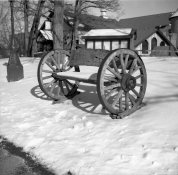


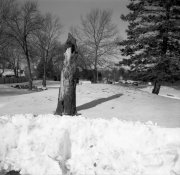


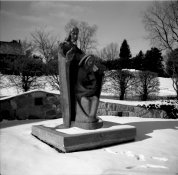

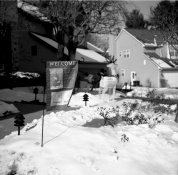

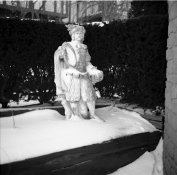
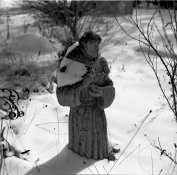
 )
)
